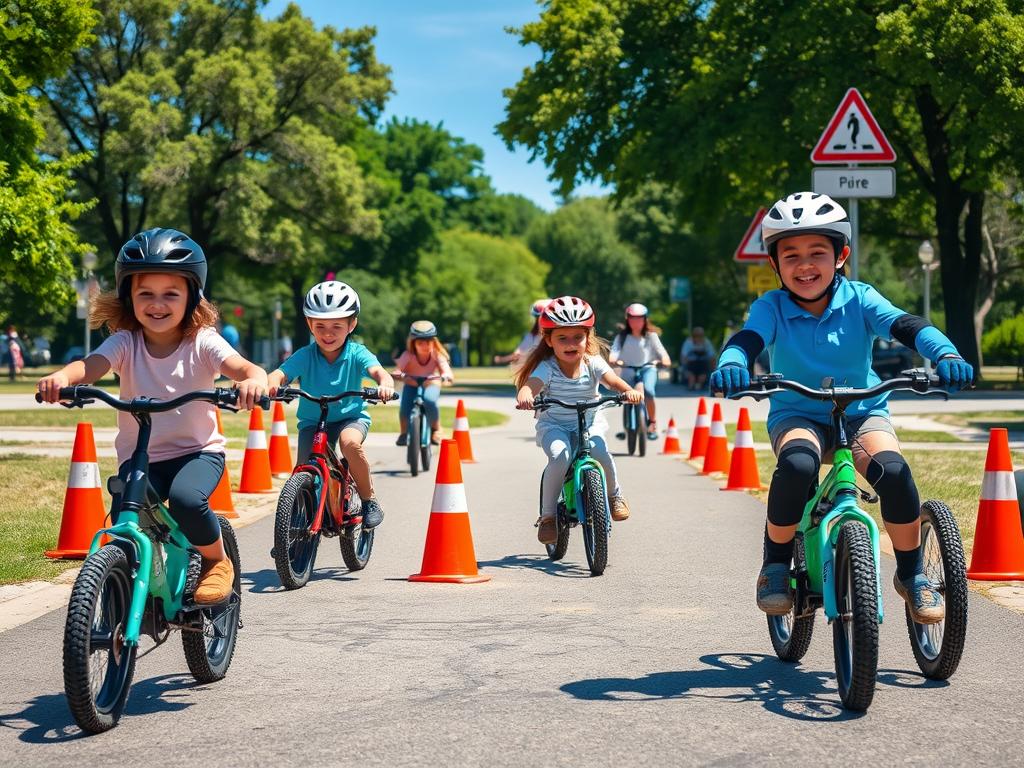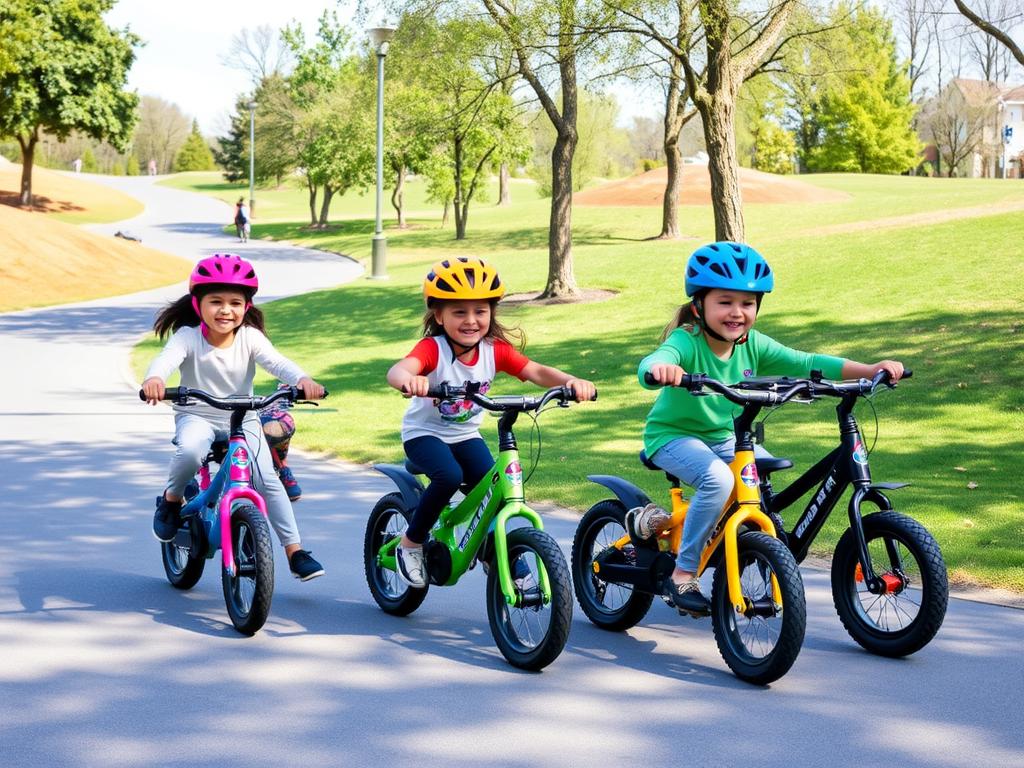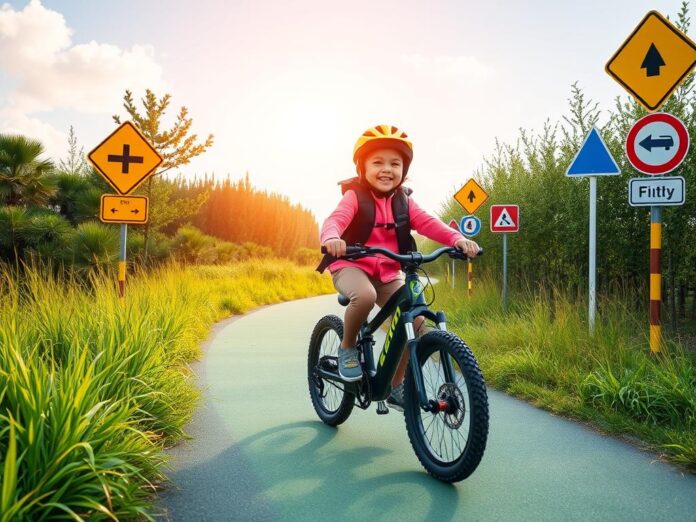Electric bicycles (e-Bikes) are becoming more popular as a green and easy way to get around. It’s important to teach kids and new riders how to ride safely. Since e-Bikes can go faster and farther than regular bikes, it’s key to make sure everyone has a good and safe ride.
If you’re a parent wanting to teach your child to ride an e-Bike or an adult new to this eco-friendly way of getting around, this guide is for you. We’ll cover the basics of riding an e-Bike safely. You’ll learn about e-Bike features, safety tips, and how to ride confidently and responsibly.
Key Takeaways
- E-Bikes offer a faster and more convenient mode of transportation, but proper training is crucial for safe riding, especially for kids and beginners.
- Understanding the features and safety considerations of e-Bikes is essential before taking to the road.
- Mastering fundamental riding techniques, such as balancing, starting, stopping, and turning, will help build confidence and ensure a safe riding experience.
- Prioritizing safety gear, including helmets and protective clothing, is a must for all e-Bike riders, regardless of age or experience level.
- Familiarizing yourself with traffic rules and etiquette will help you share the road safely with other cyclists, pedestrians, and motorists.
Understanding e-Bikes: What You Need to Know
As more kids and beginners take up biking, it’s key to grasp what e-bikes are. These bikes mix traditional cycling with electric power. They’re changing how we travel and explore.
Definition and Features of e-Bikes
E-bikes have electric motors that help you ride. They make it easier to tackle tough paths and go further. There are three types: Class I, II, and III, based on how fast you can go.
Benefits of Riding an e-Bike
Riding an e-bike has many perks, especially for new cyclists. They help you travel longer distances and tackle hills with ease. A survey found that 94% of new riders used their e-bikes daily or weekly.
Safety Features Commonly Found
E-bikes come with safety features to keep you safe. They have special brakes and stickers that show how fast they can go. This helps everyone on the road know what to expect.
Knowing about e-bikes is vital for those new to biking. By understanding their features and safety, you can enjoy riding them safely and responsibly.
Selecting the Right e-Bike for Kids
Choosing the right e-bike for your child is key. It should match their age and size. The right bike offers a safe and fun ride, building a lifelong cycling love. Remember these important points as you look into youth e-bike training and kids e-bike safety.
Age and Size Considerations
The e-bike’s size and weight must fit your child. A bike too big or heavy is hard to control, posing safety risks. Look for bikes with adjustable seats and handlebars that grow with your child. This ensures a comfortable and confident ride.
Types of e-Bikes Suitable for Beginners
For young riders, Class 1 and Class 2 e-bikes are best. They offer pedal-assist up to 20 mph, helping build confidence and safety. Many brands have e-bikes for kids, with lightweight frames, lower power, and safety features.
Important Safety Certifications to Look For
Ensure the e-bike you choose has passed strict safety tests. In the U.S., the UL2272 certification checks the battery and electrical systems. Also, check if it meets local laws, like wearing a helmet in California for riders under 16.
By considering your child’s age and size, focusing on safety, and picking the right e-bike, you offer a fun and safe ride. This sets the stage for a lifelong cycling passion. Check out the wide selection of youth e-bikes available to find the perfect one for your young adventurer.

Essential Safety Gear for Young Riders
Teaching kids to ride e-bikes or introducing e-bike fundamentals for novices is crucial. The right safety gear is key to keeping young riders safe. It also helps them love the sport for life.
Helmets: Choosing the Right One
A good helmet is a must for e-bike riding. Look for helmets that meet safety standards and have MIPS for extra protection. Make sure the helmet fits well and is easy to see.
Protective Clothing and Accessories
Protective clothing and accessories are also vital. Gloves, knee pads, and elbow pads help prevent injuries. Wear long-sleeved shirts, pants, and sturdy shoes to stay safe.
Importance of Visibility Gear
Being seen is crucial, especially at night. Use reflectors and lights on the bike and clothes. This helps prevent accidents.
| Safety Gear | Importance | Recommended Features |
|---|---|---|
| Helmet | Protects the head from impact | MIPS technology, bright colors, reflective elements |
| Gloves | Prevents hand injuries in case of a fall | Padded palms, secure fit |
| Knee and Elbow Pads | Cushions impact on joints and reduces scrapes | Comfortable and flexible, adjustable straps |
| Reflective Clothing | Enhances visibility for other road users | Reflective strips, flashing lights |
By focusing on safety gear, parents and instructors can make e-biking safe and fun for kids. With the right gear and responsible riding, kids can enjoy e-biking. They’ll learn important skills and develop a lifelong love for the sport.
Teaching Basic Riding Skills
Learning to ride an e-Bike is all about mastering a few key skills. These include balancing, starting, stopping, turning, and steering. It’s important to practice these basics in a safe place before riding on roads or trails.
Balancing Techniques
Keeping your balance is key to riding an e-Bike. Start by practicing in a flat, open area. Focus on how your body is positioned and how your weight is spread out. Try shifting your weight from side to side to feel the bike’s balance.
Also, keep your eyes looking forward, not down. This helps with your balance.
Starting and Stopping Safely
It’s important to smoothly start and stop the e-Bike’s motor. When starting, add power slowly to the pedals or throttle. This helps you accelerate smoothly.
For stopping, use the brakes slowly and evenly. Keep your body centered over the bike. Practice these moves at low speeds until you feel confident.
Turning and Steering Fundamentals
Turning and steering the e-Bike takes practice and coordination. Start with wide, gentle turns. Shift your weight and guide the handlebars gently.
As you get better, try tighter turns and more precise steering. Keep your body relaxed and your eyes on your path.
Learning these basic skills in a safe place will help you feel more confident and skilled. This is especially true for e-Bike Teaching Kids and Beginners and electric bicycle lessons.
| Skill | Description | Key Considerations |
|---|---|---|
| Balancing | Maintaining stability and control of the e-Bike | Body positioning, weight distribution, eye focus |
| Starting and Stopping | Engaging and disengaging the motor smoothly | Gradual acceleration, even braking, body positioning |
| Turning and Steering | Navigating turns and guiding the e-Bike’s direction | Weight shifting, handlebar control, visual focus |
“Learning to ride an e-Bike should be a fun and rewarding experience. By mastering the basic skills in a safe environment, you’ll be well on your way to enjoying the freedom and convenience of electric-assisted cycling.”
Understanding Traffic Rules and Etiquette
Starting your bike riding education means learning the traffic rules and etiquette. Knowing these rules keeps you safe and helps everyone get along on the road.
Importance of Knowing the Rules
Knowing the traffic rules is key for your safety and others’. By following these rules, you make the road safer for everyone. It also shows respect for others and sets a good example, especially for young cyclists.
Key Rules for e-Bike Riders
- Stop at all traffic signals and signs, ensuring you look both ways before proceeding.
- Ride in the appropriate lane, following the direction of traffic flow.
- Use hand signals to indicate your turns and lane changes well in advance.
- Yield the right-of-way to pedestrians, especially at crosswalks and intersections.
- Maintain a safe following distance from other vehicles, allowing enough space to stop safely.
- Obey the posted speed limits and adjust your speed based on road conditions.
How to Share the Road Safely
Sharing the road with others requires attention and care. Always be alert and ready to react. Ride in a way that others can predict your actions. Be careful when passing parked cars and watch out for pedestrians.
By being respectful and understanding, we can make the roads safer for everyone. This is especially important for bike riding education and teaching young cyclists.

“Riding an e-bike responsibly and following the rules of the road not only keeps you safe but also sets an example for the next generation of cyclists.”
Safe bike riding means being aware of your surroundings and anticipating dangers. By following the rules, you become a confident and responsible e-bike rider. This helps create a future where bike riding education and cycling instruction for youth are key to a sustainable transport system.
Creating a Safe Learning Environment
Teaching beginner bikers, including kids and youth, needs a safe space. The right spot, a good course design, and few distractions help a lot. This makes learning to ride an e-bike fun and easy.
Choosing the Right Location for Practice
The best place for beginner biking classes and youth e-bike training is open and flat. It should have little traffic and no big obstacles. Places like empty parking lots or quiet parks are perfect. They let new riders learn without the stress of busy roads or rough paths.
Setting Up a Safe Course
After picking a spot, set up a safe course. Use cones or small barriers for turning practice. Painted lines or markers help keep riders on track. The aim is to make a place where skills can grow slowly and safely.
Minimizing Distractions
Keep distractions low during training. Pick a quiet spot away from busy areas. Turn off or silence devices nearby. Make sure everyone is focused. A calm space helps students feel more confident and skilled.
For a safe and successful beginner biking classes or youth e-bike training program, plan well. Choose the right spot, design a good course, and keep distractions away. This way, your students will learn to ride e-bikes safely and confidently.
Building Confidence on an e-Bike
Teaching kids to ride e-bikes safely is more than just learning to ride. It’s about building their confidence. This confidence will improve their riding skills and make them love e-biking more. By starting slow, being positive, and encouraging them to ride alone, you can help them feel more sure of themselves.
Gradual Skill Progression
Building confidence on an e-bike means going slow. Start with simple things like balancing and stopping. Then, add more skills like turning. Practice in a safe place before riding on busy roads. This way, kids will feel more in control and confident with each new skill.
Positive Reinforcement Strategies
Positive words and actions are great for boosting confidence. Celebrate every small win and encourage them when they face challenges. Praise, high-fives, or small treats can motivate them to keep learning. This makes learning fun and builds their confidence.
Encouraging Independence While Riding
As they get better, let them ride more on their own. Encourage them to make their own decisions, like navigating turns. This helps them feel more independent and confident. Just remember to be there to guide them and keep them safe.
Building confidence on an e-bike is a journey. It’s important to adjust your teaching to fit your child’s needs. By using these strategies, you can help kids become confident and skilled e-bike riders.

Tips for Monitoring Riding Progress
When teaching kids and beginners about e-bike riding, watch their progress closely. Set goals, keep a riding log, and check their skills often. This ensures they grow and get better safely.
Setting Achievable Goals
Start by helping your young riders set goals they can reach. Goals might include learning to balance, start, and stop. Or maybe they want to master cornering, ride with one hand, or brake better. Break down learning into smaller steps to boost their confidence and keep them excited.
Keeping a Riding Log
Ask your riders to log their rides. Note the date, time, where they rode, skills practiced, and any challenges. This log shows where they’re doing well and where they need more work. It’s a great tool as they learn more about e-bike fundamentals for novices.
Regularly Assessing Riding Skills
It’s important to check their skills often. Watch how they ride, their decisions, and give feedback to help them get better. This helps you see where they need more practice or lessons. It lets you adjust your e-Bike Teaching Kids and Beginners lessons to fit their needs.
Using these tips, you can help your young e-bike riders become skilled and confident. They’ll be able to enjoy e-biking safely and have fun doing it.
Understanding e-Bike Maintenance
Starting your electric bicycle lessons or bike riding education? It’s key to know how to maintain your e-bike. Regular care and checks keep your bike safe and reliable for kids and beginners.
Basic Maintenance Tasks for Beginners
Keeping your e-bike in good shape is easy. Check the tire pressure and make sure the brakes work right. Clean the chain and use lubricant to keep it moving smoothly.
Also, check the battery and electrical parts before each ride. This ensures everything is working well.
Signs of Wear and When to Seek Help
While you can handle basic care, some signs need a pro’s help. Listen for odd noises, check for tire or brake wear, and watch battery life. If you see these, get a qualified e-bike tech to check it out.
Importance of Regular Inspections
Regular checks are vital for e-bike care. Before each ride, look over your bike for any issues. Check the tires, brakes, and battery. This habit helps you spot and fix problems fast, keeping your bike safe and fun to ride.
| Component | Lifespan |
|---|---|
| Motor | Direct drive up to 10,000 miles, geared motor 3,000-10,000 miles |
| Tires | 1,000 to 3,000 miles |
| Rim Brakes | Up to 3,000 miles |
| Disc Brakes | Up to 6,000 miles |
| E-Bike Lifespan | Generally around 3-5 years |
Knowing basic maintenance, recognizing wear signs, and doing regular checks are key. This way, you’ll enjoy your electric bicycle lessons or bike riding education while keeping your e-bike in great shape. Remember, proper care is essential for a safe and fun ride.
Transitioning to Real-World Riding
As your child gets more comfortable on their e-bike, it’s time to ride in real-world places. This step is key for improving their skills and getting ready for road challenges.
When to Move Beyond Practice Areas
When your child can start, stop, turn, and control their e-bike well, they’re ready for real-world riding. Look for steady balance, good decision-making, and following traffic rules. Remember, e-bikes can go up to 28 mph, so they need the right skills and maturity.
Riding with a Group vs. Solo
- Riding with others can be fun and supportive, teaching your child from more experienced riders.
- Solo riding helps your child become independent but needs more awareness and decision-making.
- Think about your child’s personality, confidence, and riding skills to decide between group or solo riding.
Planning Safe Routes for Long Rides
For longer rides, pick safe routes with bike lanes, paths, and roads with less traffic. Avoid busy areas and roads without cycling paths. Know the local cycling laws to teach your child how to ride safely.
| Riding Environment | Average Speed | Key Considerations |
|---|---|---|
| Practice Area | 10-12 mph | Controlled, low-traffic setting for building fundamental skills |
| Bike Lanes/Paths | 12-15 mph | Dedicated cycling infrastructure for safer, slower-paced riding |
| Local Roads | 15-20 mph | Increased traffic awareness and adherence to traffic rules |
| Major Roads | 20-25 mph | Highest level of skill, situational awareness, and caution required |
The move to real-world riding is a gradual step. It needs careful planning, supervision, and skill development. By following these tips, you can ensure your child’s safety and confidence in cycling.
Encouraging Lifelong e-Bike Usage
E-bikes are changing the way we travel, especially for kids. Community programs and events help kids and families love e-biking. They teach skills, safety, and build a community feeling.
Community Programs and Events
Local groups and bike shops run e-bike safety workshops for kids. These teach balancing, braking, and traffic rules. They also stress the need for the right gear and safe riding.
These events help kids feel more confident and enjoy the outdoors more. They learn how e-bikes can improve their coordination.
Families Riding Together
When families ride e-bikes together, it’s great for bonding and learning. Parents can guide and support their kids. This builds a lifelong love for cycling.
E-bikes are perfect for families because they fit all ages and skill levels. They make family outings fun and memorable.
Advocating for e-Bike Awareness in the Community
It’s important to spread the word about e-bikes in our communities. We need bike-friendly roads and signs. This helps e-bikes become a normal part of our lives.
By working together, we can make our communities more active and sustainable. E-bikes are a key part of this change.






